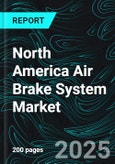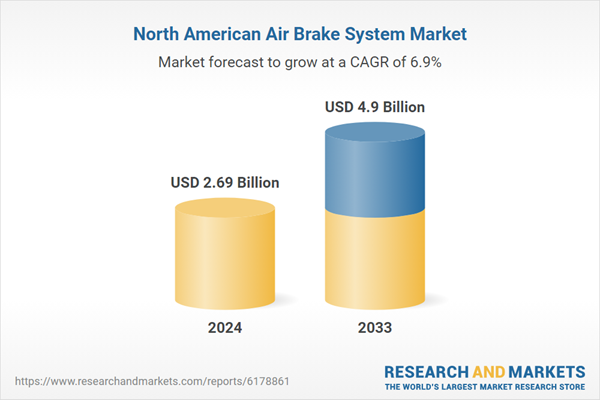North America Air Brake System Industry Overview
The market for air brake systems in North America is undergoing substantial change due to the region's increasing demand for heavy-duty commercial vehicles, urbanization, and changing safety regulations. Known for their dependability in big cars, air brake systems are still essential for maintaining efficiency and safety in industrial, passenger, and logistics applications. With the introduction of electronically controlled braking systems and integrated technologies that improve performance while lowering maintenance requirements, manufacturers and suppliers are placing an increasing emphasis on innovation.Supportive regulatory regimes that require automobiles to comply with safety standards also assist the sector. Reliable braking systems for trucks and trailers are in high demand due to the expansion of freight transportation and the quick development of e-commerce. In response, OEMs and aftermarket companies are providing customized solutions that offer improved safety standards together with cost effectiveness. In addition, the modernization of air brake technologies in North America is being aided by the incorporation of advanced driver assistance systems (ADAS).
Among Americans aged 1-541, road traffic accidents are the largest cause of death. They are also the primary cause of non-natural mortality among Americans who live or travel abroad. In Canada, there were 1,768 car-related fatalities in 2021 compared to 1,746 in 2020. 8185 severe injuries, up 4% from the 2020s, 7,868 total serious injuries, and 108,018 overall injuries, up 3.6% from the 2020s, were reported in 2021. The need for technology that encourage safe driving is growing as a result of the region's rising traffic incident frequency and demand for commercial vehicles. As a result, the North American market would expand.
Key Factors Driving the North America Air Brake System Market Growth
The push from regulations for safety compliance
One of the main factors propelling the market for air brake systems in North America is the strict automotive safety regulations. To guarantee that commercial and heavy-duty vehicles fulfill strict performance standards, especially in braking efficiency, government organizations regularly update laws. These regulations push OEMs and fleet managers to implement cutting-edge air brake systems that lower liability risks while simultaneously satisfying compliance standards. The need for dependable braking systems has increased as a result of the drive for road safety, which has also led to increases in driver education and car inspections. Because of this, regulatory influence continues to be a major factor, guaranteeing steady demand in both the OEM and aftermarket segments.Growth in Freight and E-Commerce Logistics
The rapid expansion of e-commerce and increasing freight movement across North America are significantly driving the air brake system market. With the growing need for faster and more reliable last-mile and long-haul deliveries, the demand for heavy-duty trucks and trailers has surged. Air brake systems, being essential for large commercial vehicles, ensure safety and operational efficiency, especially in high-load conditions. Logistics companies are prioritizing the modernization of fleets with advanced air braking solutions to minimize downtime and reduce risks of accidents. This ongoing transformation of the logistics ecosystem ensures long-term demand for both new installations and aftermarket replacements of air brake components.Technological Advancements in Braking Systems
Ongoing innovations, such as electronically controlled braking systems (ECBS), integrated braking with ADAS, and telematics-enabled monitoring, are transforming the air brake system market in North America. These technologies improve braking response times, enhance driver control, and reduce maintenance costs by offering predictive diagnostics. Manufacturers are increasingly collaborating with technology providers to create connected and smart braking systems that align with future mobility trends. Fleet operators benefit from reduced operational risks, while OEMs gain a competitive edge through differentiated offerings. The growing adoption of advanced technologies makes innovation a central driver for the sustained growth of the North America air brake system market.Challenges in the North America Air Brake System Market
High Maintenance and Operational Costs
Air brake systems, while reliable, require significant upkeep compared to hydraulic braking systems. Regular inspections, replacement of components, and system calibration lead to higher maintenance costs, particularly for large fleets operating in demanding conditions. For small fleet operators or independent truckers, these costs can become a burden, limiting the speed of adoption of advanced systems. Additionally, the need for specialized repair and replacement parts can contribute to downtime and operational inefficiencies. While OEMs and suppliers are working toward more durable and cost-effective solutions, the financial implications of maintenance remain a persistent challenge for market expansion.Supply Chain Disruptions and Raw Material Volatility
The North American air brake system market faces challenges stemming from global supply chain disruptions and fluctuating raw material prices. Critical components, such as compressors and valves, rely on steady supplies of metals and other inputs, which have seen price volatility in recent years. Any disruption in supply chains, whether due to geopolitical issues or logistical bottlenecks, can directly impact the cost structure of manufacturers and delay deliveries. Furthermore, localized shortages of skilled labor add to the complexity of maintaining stable production output. These factors increase uncertainty in the market and may limit the ability of suppliers to meet rising demand effectively.North America Air Brake System Market Overview by Regions
The North America air brake system market spans the United States, Canada, and Mexico, with each country contributing uniquely to demand growth, regulatory influence, and industrial adoption across commercial vehicles and transport infrastructure. The following provides a market overview by region:United States Air Brake System Market
The United States represents the largest share of the North America air brake system market, owing to its expansive commercial vehicle fleet and stringent safety regulations. The country’s logistics and freight industry relies heavily on heavy-duty trucks and trailers, creating consistent demand for reliable braking solutions. Regulatory agencies mandate compliance with advanced safety standards, which drives the adoption of modern air brake technologies. Additionally, U.S.-based manufacturers are at the forefront of innovation, integrating electronic systems and telematics into braking solutions. The aftermarket segment also plays a key role, with a strong emphasis on regular inspection and replacement cycles. Overall, the U.S. market is set for steady growth, supported by its mature infrastructure and ongoing emphasis on road safety.Canada Air Brake System Market
The Canadian air brake system market is influenced by unique factors such as long-haul transport across challenging terrains and cold weather conditions. These conditions necessitate highly reliable and durable braking solutions for trucks, buses, and trailers. Canada’s regulatory framework supports advanced safety compliance, making air brake systems a critical requirement in commercial vehicles. The rise in cross-border trade with the U.S. also contributes to growing demand for standardized braking systems that meet both countries’ compliance benchmarks. OEMs and suppliers are focusing on solutions adapted for extreme weather, ensuring resilience and safety. With increasing investments in transportation infrastructure and logistics networks, Canada continues to be a promising market within North America for air brake systems.Mexico Air Brake System Market
Mexico’s air brake system market is expanding due to the country’s growing role as a manufacturing and logistics hub in North America. With rising industrial output and cross-border trade, the demand for commercial vehicles is steadily increasing. Air brake systems are crucial in ensuring the safety and efficiency of heavy-duty trucks that transport goods domestically and internationally. The Mexican government’s efforts to modernize transportation infrastructure, along with rising investment from OEMs, further strengthen the market. Additionally, the increasing integration of Mexico into regional supply chains creates opportunities for both OEM and aftermarket segments. Although challenges such as infrastructure gaps remain, Mexico represents a high-growth segment within the broader North American air brake system industry.Market Segmentations
Type
- Air Drum
- Air Disc
Component
- Compressor
- Governor
- Tank
- Air Dryer
- Foot Valve
- Brake Chamber
- Slack Adjuster
- Others
Application
- Truck
- Bus
- Rolling Stock
Country
- United States
- Canada
All the Key players have been covered
- Overviews
- Key Persons
- Recent Developments
- SWOT Analysis
- Revenue Analysis
Company Analysis:
- ZF Friedrichshafen AG
- Haldex Group
- Nabtesco Corporation
- Knorr-Bremse AG
- Wabtec Corporation
- TSE Brakes Inc.
- Fedral-Mogul Holding Corporation
- Meritor Inc.
Table of Contents
Companies Mentioned
- ZF Friedrichshafen AG
- Haldex Group
- Nabtesco Corporation
- Knorr-Bremse AG
- Wabtec Corporation
- TSE Brakes Inc.
- Fedral-Mogul Holding Corporation
- Meritor Inc.
Methodology
In this report, for analyzing the future trends for the studied market during the forecast period, the publisher has incorporated rigorous statistical and econometric methods, further scrutinized by secondary, primary sources and by in-house experts, supported through their extensive data intelligence repository. The market is studied holistically from both demand and supply-side perspectives. This is carried out to analyze both end-user and producer behavior patterns, in the review period, which affects price, demand and consumption trends. As the study demands to analyze the long-term nature of the market, the identification of factors influencing the market is based on the fundamentality of the study market.
Through secondary and primary researches, which largely include interviews with industry participants, reliable statistics, and regional intelligence, are identified and are transformed to quantitative data through data extraction, and further applied for inferential purposes. The publisher's in-house industry experts play an instrumental role in designing analytic tools and models, tailored to the requirements of a particular industry segment. These analytical tools and models sanitize the data & statistics and enhance the accuracy of their recommendations and advice.
Primary Research
The primary purpose of this phase is to extract qualitative information regarding the market from the key industry leaders. The primary research efforts include reaching out to participants through mail, tele-conversations, referrals, professional networks, and face-to-face interactions. The publisher also established professional corporate relations with various companies that allow us greater flexibility for reaching out to industry participants and commentators for interviews and discussions, fulfilling the following functions:
- Validates and improves the data quality and strengthens research proceeds
- Further develop the analyst team’s market understanding and expertise
- Supplies authentic information about market size, share, growth, and forecast
The researcher's primary research interview and discussion panels are typically composed of the most experienced industry members. These participants include, however, are not limited to:
- Chief executives and VPs of leading corporations specific to the industry
- Product and sales managers or country heads; channel partners and top level distributors; banking, investment, and valuation experts
- Key opinion leaders (KOLs)
Secondary Research
The publisher refers to a broad array of industry sources for their secondary research, which typically includes, however, is not limited to:
- Company SEC filings, annual reports, company websites, broker & financial reports, and investor presentations for competitive scenario and shape of the industry
- Patent and regulatory databases for understanding of technical & legal developments
- Scientific and technical writings for product information and related preemptions
- Regional government and statistical databases for macro analysis
- Authentic new articles, webcasts, and other related releases for market evaluation
- Internal and external proprietary databases, key market indicators, and relevant press releases for market estimates and forecasts

LOADING...
Table Information
| Report Attribute | Details |
|---|---|
| No. of Pages | 200 |
| Published | September 2025 |
| Forecast Period | 2024 - 2033 |
| Estimated Market Value ( USD | $ 2.69 Billion |
| Forecasted Market Value ( USD | $ 4.9 Billion |
| Compound Annual Growth Rate | 6.9% |
| Regions Covered | North America |
| No. of Companies Mentioned | 8 |









